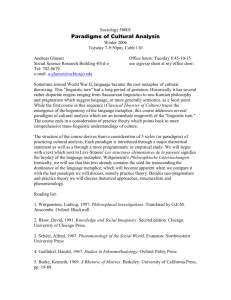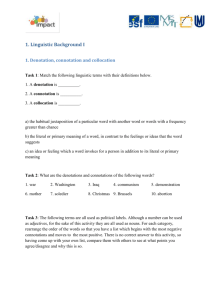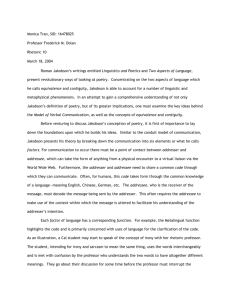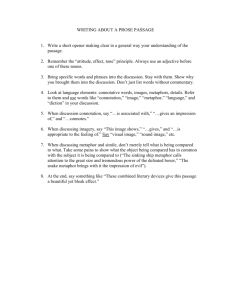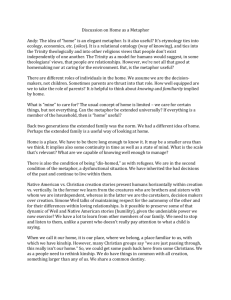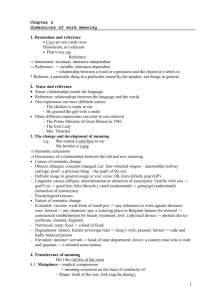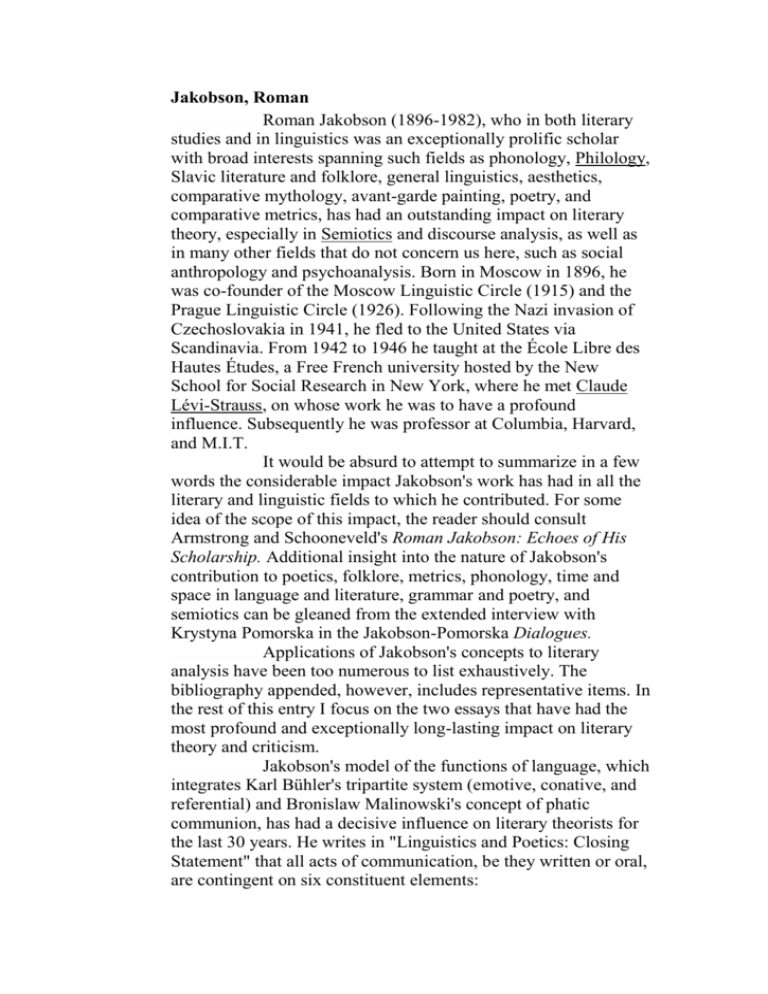
Jakobson, Roman
Roman Jakobson (1896-1982), who in both literary
studies and in linguistics was an exceptionally prolific scholar
with broad interests spanning such fields as phonology, Philology,
Slavic literature and folklore, general linguistics, aesthetics,
comparative mythology, avant-garde painting, poetry, and
comparative metrics, has had an outstanding impact on literary
theory, especially in Semiotics and discourse analysis, as well as
in many other fields that do not concern us here, such as social
anthropology and psychoanalysis. Born in Moscow in 1896, he
was co-founder of the Moscow Linguistic Circle (1915) and the
Prague Linguistic Circle (1926). Following the Nazi invasion of
Czechoslovakia in 1941, he fled to the United States via
Scandinavia. From 1942 to 1946 he taught at the École Libre des
Hautes Études, a Free French university hosted by the New
School for Social Research in New York, where he met Claude
Lévi-Strauss, on whose work he was to have a profound
influence. Subsequently he was professor at Columbia, Harvard,
and M.I.T.
It would be absurd to attempt to summarize in a few
words the considerable impact Jakobson's work has had in all the
literary and linguistic fields to which he contributed. For some
idea of the scope of this impact, the reader should consult
Armstrong and Schooneveld's Roman Jakobson: Echoes of His
Scholarship. Additional insight into the nature of Jakobson's
contribution to poetics, folklore, metrics, phonology, time and
space in language and literature, grammar and poetry, and
semiotics can be gleaned from the extended interview with
Krystyna Pomorska in the Jakobson-Pomorska Dialogues.
Applications of Jakobson's concepts to literary
analysis have been too numerous to list exhaustively. The
bibliography appended, however, includes representative items. In
the rest of this entry I focus on the two essays that have had the
most profound and exceptionally long-lasting impact on literary
theory and criticism.
Jakobson's model of the functions of language, which
integrates Karl Bühler's tripartite system (emotive, conative, and
referential) and Bronislaw Malinowski's concept of phatic
communion, has had a decisive influence on literary theorists for
the last 30 years. He writes in "Linguistics and Poetics: Closing
Statement" that all acts of communication, be they written or oral,
are contingent on six constituent elements:
CONTEXT
MESSAGE
ADDRESSER . . . . . ADDRESSEE
CONTACT
CODE
A message is sent by an addresser to an addressee.
For this to occur, the addresser and addressee must use a common
code, a physical channel, or contact, and the same frame of
reference, or context. (Though Jakobson stipulates that by
"context" he means "referent," the term is confusing, since it
could be mistakenly construed as pointing to the circumstances of
utterance rather than to what the message is about.) Each of the
constituent elements of the communicative act has a
corresponding function; thus:
REFERENTIAL
POETIC
EMOTIVE PHATIC CONATIVE
METALINGUAL
Focused on the addresser (or sender), that is, on the
first person, the emotive function reflects the speaker's attitude to
the topic of his or her discourse. As we shall see, the emotive
function can be linked to Émile Benveniste's concept of discours
(discourse). The conative function is centered on the second
person, the addressee (or receiver). The most explicit instance is
illustrated by two grammatical categories--the vocative and the
imperative--neither of which is subject to the true/false criterion
of declarative utterances.
The four other functions concern the message sent.
The referential function can be equated with the cognitive use of
language, which privileges the informational content of an
utterance, virtually eliminating the focus on the speaker or on the
addressee. The referential function can be linked to Benveniste's
concept of récit (story) as opposed to discourse, which entails the
presence of a self-conscious narrator. The poetic function (which
should not be confused with poetic discourse) valorizes the
signifier, foregrounding what might be called the decorative or
aesthetic function of language, in Jakobson's words, the message
for its own sake, thereby deemphasizing (though not necessarily
eliminating) the referential function. The metalingual function is
focused on the verbal code itself, that is, on language speaking of
itself, its purpose being to clarify the manner in which the verbal
code is used. Finally, the phatic function is centered on the
channel used and thus on the contact between speaker and
addressee.
Literary examples of Jakobson's functions of
language are easy to locate. The emotive function is to be found
especially in lyric poetry or in introspective (first-person)
narrative. The conative function is well illustrated by Michel
Butor's novel La Modification, which is written entirely in the
second person, or by Carlos Fuentes's The Death of Artemio Cruz,
sections of which are likewise written in the second person.
Examples of the poetic function abound in dadaist and surrealist
poetry. Instances of the phatic function are to be found in the
opening scene of Eugène Ionesco's Bald Soprano and in many
scenes of Harold Pinter's early plays. The metalingual function is
often the principal focus of stage directions, whose express
purpose is to clarify the dialogue and the delivery intended by the
dramatist. Finally, the referential function is dominant in
naturalist fiction by such authors as Émile Zola and Guy de
Maupassant.
Despite the apparent simplicity of Jakobson's model
of communication, his "Closing Statement" has had a marked
influence on literary Structuralism and semiotics. Perhaps almost
as influential have been his study of metaphor and metonymy
(published a few years earlier), "Two Aspects of Language and
Two Types of Aphasic Disturbances," and his concept of poetics
itself. The essay, as its title indicates, makes a suggestive use of
aphasia as methodological frame, and despite its brevity, it has
had a very widespread impact, especially on research in the
aesthetics and philosophy of metaphor. Jakobson's point, and it
seems convincing, is that we can learn as much from linguistic
communication when it breaks down or is impaired as when it
functions normally. The focus of the essay is the manner in which
aphasia affects oral expression, particularly figurative expression.
For Jakobson, in this instance adopting Ferdinand de Saussure's
distinction, there are two complementary yet radically opposed
uses of language: selection and combination. Selection, or
substitution, which is a metalingual operation, is equated with
similarity or the metaphoric use of language, whereas
combination is shown to be identical to contiguity, that is, to the
metonymic function. He demonstrates how in aphasia one or, in
extreme cases, both of these speech functions are impaired.
Aphasic impairment thus affects either the similarity (or
metaphoric) function or the contiguity (or metonymic) function.
Aphasics who have a problem with selection have to rely on
context, which enables them to react in continuing a conversation
rather than beginning one. This type of aphasic usually has
difficulty with synonyms or with similar circumlocutions.
Jakobson observes that an aphasic who has an impaired similarity
function falls back on the contiguity function. The latter can
likewise be impaired. When this occurs, the syntactic frame of the
patient's sentences collapses. Coordination and grammatical
subordination are eliminated. Jakobson posits that while the
variant types of aphasia are numerous, what is common to all of
them is the impairment of the faculty of selection or the
impairment of the faculty of combination and contextualization.
Jakobson suggests that his distinction between
metaphoric and metonymic can help categorize not only various
modes of literary discourse but also other art forms. Thus, for
example, if the metaphoric mode predominates in Romanticism
and symbolism, the metonymic mode prevails in realism. In
painting and film, the metonymic is central, particularly in film,
which makes liberal use of synecdochic closeups. (For the
purposes of this discussion, Jakobson places synecdoche and
metonymy in the same category, in contrast to metaphor.) For
Jakobson, the distinction between metaphor and metonymy is
crucial. Of course, both modes entail substitution of one term for
another, but the fundamental difference lies in the fact that
metaphor entails a transfer of meaning between normally
unrelated domains, whereas metonymy utilizes a term that is a
property of the key word or is related to it contiguously.
Michel Le Guern, in an important essay (1973) based
on Jakobson's distinction between metaphor and metonymy,
develops Jakobson's highly condensed presentation, showing how
the central thesis is far more persuasive than it may appear. There
are, for example, good reasons for placing metonymy and
synecdoche in contrast to metaphor, especially when it is realized
that whereas metaphor entails a transfer of sense, metonymy and
synecdoche entail a transfer of reference. In other words,
reference is the key to the distinction between metaphor and
metonymy. The metonymic relationship obtains between
extralinguistic entities, that is, between objects, and is in no way
contingent on the language used to express such a relationship.
Metonymy and synecdoche entail a transfer of reference and the
use of ellipsis. Metaphor (i.e., live metaphor as opposed to clichés
that have lost their figurative force) is necessarily perceived as
incongruous or surprising, at first apparently not compatible
semantically with its context. The metonymic pole is thus
essentially a referential process, located beyond language, while
the metaphoric pole is semantic and consequently intralinguistic.
Jakobson's essay has acquired a somewhat unusual
afterlife for a piece of theoretical writing. It is not common for
theory to be turned into fiction, but this is precisely the use to
which David Lodge puts the essay in Nice Work (1988), a novel
that even offers a discussion of Jakobson's theory of metaphor and
metonymy.
Michael Issacharoff
Notes and Bibliography
See also Prague School Structuralism, Semiotics, and
Structuralism.
Roman Jakobson, "Aphasia as a Linguistic Topic,"
Selected Writings, vol. 2 (1971), "Linguistics and
Poetics: Closing Statement," Style in Language (ed.
Thomas Sebeok, 1960), Questions de poétique (1973),
"Two Aspects of Language and Two Types of Aphasic
Disturbances," Fundamentals of Language (by
Jakobson and Morris Halle, 1956), Verbal Art, Verbal
Sign, Verbal Time (ed. Krystyna Pomorska and
Stephen Rudy, 1985); Roman Jakobson and Krystyna
Pomorska, Dialogues (1983).
Daniel Armstrong and Cornelis H. van Schooneveld,
eds., Roman Jakobson: Echoes of His Scholarship
(1977); Christine Brooke-Rose, A Structural Analysis
of Pound's "Usura Canto": Jakobson's Method
Extended and Applied to Free Verse (1976); Karl
Bühler, "Axiomatization of the Language Sciences,"
Karl Bühler: Semiotic Foundations of Language
Theory (by Robert E. Innis, 1982), Sprachtheorie: Die
Darstellungfunktion der Sprache (1934); Jonathan
Culler, Structuralist Poetics: Structuralism,
Linguistics, and the Study of Literature (1975);
Algirdas Julien Greimas, "L'Actualité du saussurisme,"
Le Français moderne 24 (1956); Catherine KerbratOrecchioni, L'Énonciation: De la subjectivité dans le
langage (1980); Michel Le Guern, Sémantique de la
métaphore et de la métonymie (1973); David Lodge,
The Modes of Modern Writing: Metaphor, Metonymy,
and the Typology of Modern Literature (1977);
Bronislaw Malinowski, "The Problem of Meaning in
Primitive Languages," The Meaning of Meaning (by C.
K. Ogden and I. A. Richards, 1923); Krystyna
Pomorska, "Poetics of Prose" (Jakobson, Verbal Art);
Paul Ricoeur, La Métaphore vive (1975, The Rule of
Metaphor: Multidisciplinary Studies of the Creation of
Meaning in Language, trans. Robert Czerny with
Kathleen McLaughlin and John Costello, 1977);
Michael Riffaterre, Semiotics of Poetry (1978);
Ferdinand de Saussure, Cours de linguistique générale
(1916, Course in General Linguistics, trans. Roy
Harris, 1983); Tzvetan Todorov, Poétique de la prose
(1971, The Poetics of Prose, trans. Richard Howard,
1977); Linda Waugh, "The Poetic Function and the
Nature of Language" (Jakobson, Verbal Art), Roman
Jakobson's Science of Language (1976).
Topics Index Cross-references for this Guide entry:
folklore, metonymy, story/discourse
Copyright © 1997 The Johns Hopkins University Press. All rights
reserved. This document may be used, with this notice included,
for noncommercial purposes within a purchasing institution. No
copies of this work may be distributed electronically outside of
the subscribed institution, in whole or in part, without written
permission from the JHU Press.

